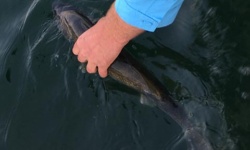Pictures appeared on social media of whooping cranes last week. Someone in a Facebook group announced that if you went to the 101 Bridge in Shakopee, Minn., you could see them, and on my next Friday off I went for a look.
Even though this bridge is over a busy roadway on the Minnesota River, there’s a nice bike and pedestrian trail so you can view the habitat below. The birds are far enough away that no matter the crowd, it won’t be any worse than the mass of cars speeding past at rush hour.
I found this area of the Minnesota River loaded with young egrets and herons honing their fishing techniques. There were even a couple of sandhill cranes. It was a treat to watch the whoopers and get an idea of just how big they are compared to other species. The bridge is loaded with spiders, and cedar waxwings were hopping on the railing trying to get to them. What a great birding site.
Over the years I’ve been familiar with whooping cranes popping up outside of Wisconsin, where they were released from captive breeding programs. Now and then a whooper or two will veer west and end up in North Dakota and Minnesota. Because of their endangered status, the locations of the birds generally remain on the down-low so people will not disturb them.
This summer has produced a lot of whooping crane activity. The locations weren’t blasted all over, but I had enough friends posting photos of cranes with vague locations on social media that I knew some were near the metro area. If you use eBird to determine what birds are reported, the exact locations of recent whooping cranes sightings usually stay hidden. They are part of the “sensitive species” list that doesn’t divulge the exact locations of some birds to prevent disturbance – or worse, poaching.
The big question many birders have is: Are they countable? The short answer is yes, it’s your list, your rules. But if you are following American Birding Association or Minnesota Ornithologists’ Union rules, that answer is less certain. The whooping cranes we’re seeing have bands and a transmitter. They appear to be two males hatched last year in captivity and raised by captive whooping cranes. They’re not chicks hatched by cranes out in the wild, which makes them less likely to be officially countable, but it’s still cool to see whooping cranes surviving in the wild.
Will these birds start nesting outside of Wisconsin? Will we get some countable breeding whooping cranes in Minnesota? Anything is possible as more of these birds get a toehold across the region.






